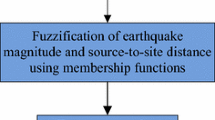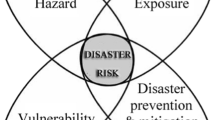Abstract
To deal effectively with the evaluation problem of natural disaster risk system affected by many uncertain factors, a multivariate connection number expression is presented. This expression is based on the index samples and evaluation grade criterions of natural disaster risk system and is capable of describing the hierarchy property and fuzziness of membership relationship between index samples and evaluation grade criterions. In this proposed method, the fuzzy evaluation grade criterion problem is resolved by combining triangular fuzzy numbers with multivariate connection number theory, and triangular fuzzy numbers are used to express the discrepancy degree coefficients of connection number and evaluation index weights. Accordingly, a connection number-based evaluation method for the natural disaster system of China (named CN-TFN for short) is established using triangular fuzzy numbers and stochastic simulation. The application results show that the spatial distribution of natural disaster risk grades of China has the trend of aggrandizement from west to east of China. The economically developed and densely populated coastal areas are very likely to have a high level of natural disaster risk grade or above; thus, these areas are the key regions of the natural disaster risk management of China. The results also show that the CN-TFN is able to reflect practical conditions of the evaluation problem of natural disaster system and to provide more reliability information as compared to the existing evaluation methods. This is as a result of its comprehensive usage of various information of subjective and objective uncertainties in the evaluation process of natural disaster risk system and its expression by confidence intervals. Due to the simplicity and generalization, the CN-TFM is applicable to comprehensive risk grade evaluation of various natural disaster systems.

Similar content being viewed by others
References
Birkmannn J (2006) Measuring vulnerability to hazards of national origin. UNU Press, Tokyo
Bruijn KM, Green C, Johnson C, Mcfadden L (2007) Evolving concepts in flood risk management: searching for a common language. Flood risk management in Europe. Springer, Berlin
Chen SY, Guo Y (2006) Variable fuzzy sets and its application in comprehensive risk evaluation for flood-control engineering system. Fuzzy Optim Decis Mak 5(2):153–162
Jin GY (1993) Stochastic analysis for hydrology and water resources. Science and Technology Press of China, Beijing
Jin JL, Wei YM (2008) Generalizes intelligent assessment methods for complex systems and applications. Science Press, Beijing
Jin JL, Wu KY, Li RZ (2008) Coupling method of stochastic simulation with triangular fuzzy numbers for water environment risk assessment. J Hydraul Eng 39(11):1257–1261, 1266
Li RZ, Hong TQ, Jin JL (2007) Research on fuzzy risk assessment model for river water quality. J Wuhan Univ Technol 29(2):43–46
Liu L, Dai HX (2004) The comprehensive assessment and regionalization of natural disaster insurance risk in China. J Mt Res 22(4):477–482
Ronald EG, Robert EY (1997a) Analysis of the error in the standard approximation used for multiplication of triangular and trapezoidal fuzzy numbers and the development of a new approximation. Fuzzy Sets Syst 91(1):1–13
Ronald EG, Robert EY (1997b) A parametric representation of fuzzy numbers and their arithmetic operators. Fuzzy Sets Syst 91(2):185–202
Shang YR (2000) Regional agricultural drought vulnerability analysis: take the agricultural drought vulnerability research in Hebei Province as an example. Beijing Normal University, Beijing
Wang WS, Li YQ, Jin JL et al (2009) Set pair analysis for hydrology and water resources. Science Press, Beijing
Wei YM, Jin JL, Yang CJ et al (2002) Risk management theory of flood disaster. Science Press, Beijing
Wu KY, Jin JL, Pan ZW (2009) Assessment model of connection number theory for urban flood-waterlogged disaster vulnerability based on triangular fuzzy intervals under cut set. J Hydraul Eng 41(6):711–719
Zhao KQ (2000) Set pair analysis theory and its elementary application. Zhejiang Science and Technology Press, Hangzhou
Zhao KQ (2007) The application of SPA-based identical-discrepancy-contrary system theory in artificial intelligence research. Caai Trans Intell Syst 2(5):20–35
Zhao WJ, Wu KY, Jin JL (2007) Set pair analysis: variable fuzzy set model for flood control engineering security evaluation. Water Resour Power 25(2):5–7, 13
Acknowledgments
The authors would like to thank the support of the National Natural Science Foundation of China under the grant Nos. 51079037 and 71020107026, the CAS Strategic Priority Research Program Grant No. XDA05150600, the National Key Technologies R&D Program of China during the 11th Five-year Plan Period (No. 2008BAC38B04-03-04), and the Opening Foundation of Chengdu Institute of Plateau Meteorology, China Meteorological Administration (LPM2011002). We thank the two anonymous reviewers for helpful comments and suggestions on the earlier draft of our paper according to which we improved the content.
Author information
Authors and Affiliations
Corresponding author
Rights and permissions
About this article
Cite this article
Jin, JL., Wei, YM., Zou, LL. et al. Risk evaluation of China’s natural disaster systems: an approach based on triangular fuzzy numbers and stochastic simulation. Nat Hazards 62, 129–139 (2012). https://doi.org/10.1007/s11069-011-0005-4
Received:
Accepted:
Published:
Issue Date:
DOI: https://doi.org/10.1007/s11069-011-0005-4




